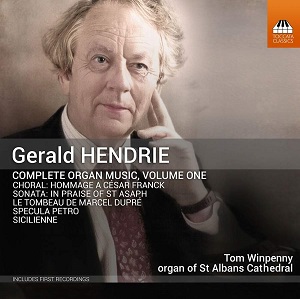
Gerald Hendrie (b. 1935)
Complete Organ Music Volume 1
Le Tombeau de Marcel Dupré (1990-1992)
Sicilienne: Hommage à Maurice Duruflé (2022)
Choral: Hommage à César Franck (1990)
Specula Petro (1968)
Sonata: In Praise of St Asaph / Mawl i Asaff Sant (1994)
Tom Winpenny (organ)
rec. 2022, Cathedral and Abbey Church of St Alban, St Albans, UK
Toccata Classics TOCC0684 [79]
Gerald Hendrie is an English scholar, composer, organist, pianist and harpsichordist. The Society of Old Framlinghamians offers a short biography, and Hendrie introduces his life and times in the booklet (which is also available at the relevant Toccata Classics webpage). I am beholden to the author in the preparation of my review.
Le Tombeau de Marcel Dupré consists of three preludes/toccatas and fugues, and Two Sketches on the name BACH. Hendrie insists that they are not ‘parodies’ of Dupré’s remarkable Trois Préludes et Fugues op. 7 from around 1912 (not 1918 as written in the liner notes) or his Deux Esquisses issued in 1946. Yet even a cursory hearing suggests that the Frenchman’s music was a model: they ‘hold up a mirror to them and endeavour to reflect something of the style and spirit of each’. In the opening Toccata, there is the virtuosic passage work in both pedals and manuals typical of the genre. The Fugue, quite jazzy, ends with a jazz player’s added sixth chord.
The following Prelude and Fugue is quiet, slow and restrained. The third piece, in G minor, presents a rapid but sustained will o’ the wisp Prelude, followed by an energetic Fugue. It is based on the notes B-A-C-H and its retrograde. Equally airy is the first of the Two Sketches on BACH, whereas the second, ‘bold and dramatic’, brings the sequence to a stunning conclusion. I am not sure if Le Tombeau de Marcel Dupré ought to be played as a collection, or if it is fine to excerpt. To be sure, the preludes/toccatas and fugues were all published separately. On the other hand, it is satisfying to hear the complete 34-minute work.
The Sicilienne: Hommage à Maurice Duruflé is dedicated to Tom Winpenny. It was inspired by the movement from the French composer’s 1933 Suite op. 5. Both are episodic in structure and use a similar lilting rhythm. It is a beautiful tribute.
The Choral: Hommage à César Franck, equally convincing, commemorated one hundred years since Franck’s death. Hendrie first studied Franck’s organ music and the Prelude, Aria and Finale for piano, and then wrote Chorale No. 4 in C minor as a pendant to the Trois Chorals which Franck completed in his last year. The nearly 14-minute Hommage is sectionalised. There is a slow introspective opening, a loud bridge passage leads to a reflective choral. Slowly but surely the music builds up to a restrained climax and then continues with rapid figuration and a powerful peroration. The piece subsides to end quietly. I wondered at first when it was to get going, but once it does, it certainly blows the cobwebs out of the organ pipes.
Specula Petro (loosely translated as Mirrors of Peter) is a twelve-tone composition. Hendrie was much influenced by Olivier Messiaen’s Livre d’orgue from 1951, and by Malcolm Williamson’s Fons Amoris from 1955-1956. The serial method is used here to define ‘pitch, rhythm and structure’. The work is a series of short, contrasting statements. It would make a fine recital piece, appealing to folk who find the Messiaen exemplar a wee bit long.
The Sonata: In Praise of St Asaph/Mawl i Asaff Sant was dedicated to the memory of the late William Mathias, who died in 1992. The four movements look at various aspects of St Asaph’s career. Hendrie explains that his sonata is ‘partly twelve-note and partly tonal’. The opening movement reflects St Asaph’s call to his vocation. It is ‘anguished at first’ but soon becomes tranquil. Plainchant is used here. The brilliant rough and tumble Fugue reflects ‘the vigour and rough simplicity of everyday medieval life’, still dominated by the church. The lovely Interlude has hints of Messiaen’s more contemplative music. It represents St Asaph at prayer, possibly in the monastery founded by St Kentigern (or Mungo). The finale, a ‘paean […] of praise for St Asaph’, uses the Scottish hymn tune St Asaph in this toccata’s progress. It is a big, powerful statement, clearly designed to bring the church down. The entire sonata represents the holy man’s journey from darkness to light and from denial to acceptance.
The comprehensive liner notes include Tom Winpenny’s reflections on the music. The recital is performed on the 1962 Harrison and Harrison organ. It was the first English cathedral instrument ‘to be voiced and built on neo-classical lines’. A full history of the instrument and the all-important specification appear in the booklet. The recording well reflects the ambience of St Alban’s Cathedral.
Gerald Hendrie has a great champion in Tom Winpenny, who is currently Assistant Master of Music at St Alban’s Cathedral. He gives a committed and technically outstanding performance of each piece. I look forward to hearing the subsequent volume of this cycle of organ music.
John France
Help us financially by purchasing from





















